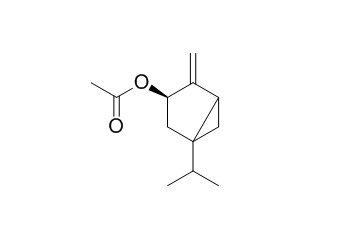Sabinyl acetate
Sabinyl Acetate has antioxidant activity, it also shows antiimplantation effect on the abortifacient effect of Juniperus sabina essential oil.
Inquire / Order:
manager@chemfaces.com
Technical Inquiries:
service@chemfaces.com
Tel:
+86-27-84237783
Fax:
+86-27-84254680
Address:
1 Building, No. 83, CheCheng Rd., Wuhan Economic and Technological Development Zone, Wuhan, Hubei 430056, PRC
Providing storage is as stated on the product vial and the vial is kept tightly sealed, the product can be stored for up to
24 months(2-8C).
Wherever possible, you should prepare and use solutions on the same day. However, if you need to make up stock solutions in advance, we recommend that you store the solution as aliquots in tightly sealed vials at -20C. Generally, these will be useable for up to two weeks. Before use, and prior to opening the vial we recommend that you allow your product to equilibrate to room temperature for at least 1 hour.
Need more advice on solubility, usage and handling? Please email to: service@chemfaces.com
The packaging of the product may have turned upside down during transportation, resulting in the natural compounds adhering to the neck or cap of the vial. take the vial out of its packaging and gently shake to let the compounds fall to the bottom of the vial. for liquid products, centrifuge at 200-500 RPM to gather the liquid at the bottom of the vial. try to avoid loss or contamination during handling.
Journal of Functional Foods2022, 96: 105216.
Front Plant Sci.2023, 14:1207940.
Compounds.2023, 3(1), 169-179.
J Pharm Pharmacol.2023, 75(9):1225-1236.
J Pharmaceut Biomed2020, 182:113110
Phytomedicine.2018, 38:12-23
South African Journal of Botany2024, 168:209-220.
Chem Biol Interact.2016, 260:168-175
International J of Green Pharmacy2019, 13(3)
Am J Chin Med.2023, 51(4):1019-1039.
Related and Featured Products
Phytochemistry, 1996, 41(1):217-223.
Biologically active flavonoids and terpenoids from Egletes viscosa.[Reference:
WebLink]
METHODS AND RESULTS:
The steam volatile components from the hexane extract of dried flower buds of Egletes viscosa were identified by gas chromatography-mass spectrometry as trans-carvyl acetate, cis-carvyl acetate, Sabinyl acetate, verbenyl acetate, cyclopentaethylidene, geranyl acetate and 5-methylfuranone, and trans-pinocarvyl acetate (major component). From the non-volatile residue, centipedic acid and a novel clerodane diterpene, 12-acetoxy-hawtriwaic acid lactone, were isolated. From the ethanol extract, ternatin (4′,5-dihidroxy-3,3′,7,8-tetramethoxyflavone), was isolated.
CONCLUSIONS:
Ternatin showed anti-inflammatory, hepatoprotection and gastroprotection properties, and, according to the NCI protocols, it showed moderate activity against HIV. The diterpenes showed antispasmodic activity. Structure determination of these secondary metabolites was accomplished by spectrometric methods, including 2D NMR, chemical interconversion and X-ray crystallographic analysis.
Phytotherapy Research, 1996, 10(5):438-440.
Sabinyl Acetate, the Main Component of Juniperus sabina L'Hérit. Essential Oil, is Responsible for Antiimplantation Effect.[Reference:
WebLink]
METHODS AND RESULTS:
The essential oil of Juniperus sabina, containing 50% Sabinyl acetate, was administered s.c. to mice at doses of 15, 45 and 135 mg/kg either on days 0–4 of pregnancy (implantation period) or on days 8–11 (organogenesis) to investigate its mechanism of action. The mice were killed on days 9 and 17 respectively. Subsequently to the previous assays, Sabinyl acetate was injected s.c. at a dose of 70 mg/kg, corresponding to the higher dose of essential oil, on days 0–4, the mice being killed on day 9. The number of prominent corpora lutea and implantation sites were recorded for mice killed on day 9. The uterine content of those killed on day 17 were examined and the fetuses removed and examined for malformations. Treatment with the oil on days 0–4 prevented pregnancy in half the mice treated with the two higher doses. The same pattern was observed with Sabinyl acetate (70 mg/kg). In contrast, treatment with the oil on days 8–11 did not impair fertility, nor did it increase the incidence of malformations compared with the results obtained for the control group.
CONCLUSIONS:
This result indicates that the abortifacient effect of Juniperus sabina essential oil is related to an implantation inhibiting effect, induced by Sabinyl acetate, the mechanism of which is being investigated.
Health scope, 2013, 1(4):171-176.
Comparative Survey on the Essential Oil Composition and Antioxidant Activity of Aqueous Extracts From Flower and Stem of Achillea Wilhelmsii From Taftan (Southeast of Iran).[Reference:
WebLink]
Achillea wilhelmsii (Asteraceae) is a Permanent herb, belongs to the genus Achillea (Compositae) Which grows wild in some regions of Iran including Taftan area of Sistan and Baluchestan, in southeast of Iran. The purpose of this study was to determine the comparative chemical composition and antioxidant activities of the essential oils extracted from the flowers, stem and leaves of Achillea wilhelmsii.
METHODS AND RESULTS:
In this study, the chemical composition of essential oils of the flower and stem of Achillea wilhelmsii from Taftan were obtained by the hydrodistillation method and analyzed by gas chromatography and gas chromatography mass spectroscopy. Sixty one compounds were identified in the essential oil of the flower. The major compounds were Camphor (27.99%), Sabinyl acetate (6.56%), Terpinene-4-ol (6.43%) Camphene (6.43%) and Alpha-Pinene (5.47%). Forty eight compounds were identified in the essential oil of the stem and leaves, which the major compounds were Camphor (34.49%), Alpha-Pinene (8.16%), Camphene (7.87%), Terpinene-4-ol (5.70%), 1,8-Cineole (3.32%). In addition, the antioxidant activity of ethanolic extract was evaluated using the 1, 1-diphenyl-2-picrylhydrazyl (DPPH) radical scavenging method.
CONCLUSIONS:
According to antioxidant activity outcomes, the amount of IC50s of aqueous extracts of flower and stem and also butylated hydroxyl toluene (BHT) as standard were 232.34, 63.25 and 45.59 ppm respectively. Ultimately, it was highlighted that antioxidant activity of aqueous extract of flower was weaker than stem.



